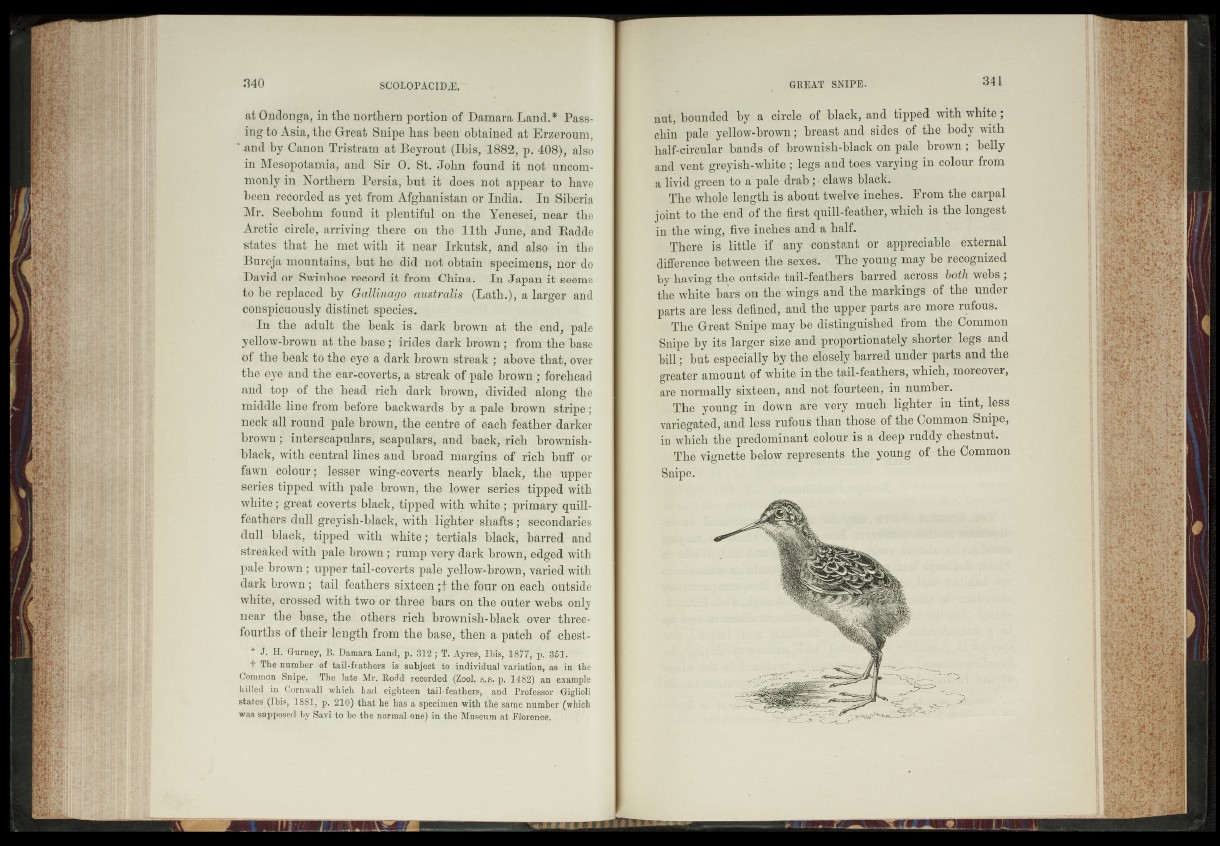
at Ottdonga, in the northern portion of Damara Land.* Passing
to Asia, the Great Snipe has been obtained at Erzeroum,
’ and by Canon Tristram at Beyrout (Ibis, 1882, p.'408),r also
in Mesopotamia, and Sir 0. St, John found it not uncommonly
in Northern Persia, but it does not appear to have
been recorded as yet from Afghanistan or India. In Siberia
Mr. Seebohm found it plentiful on the ; Yenesei, near the
Arctic circle, arriving there on the 11th June, and Radde
states that he met with it near Irkutsk, and also -in the
Bureja mountains, but he did not obtain specimens, nor do
David or Swinhoe record it'from China. In Japan it seems
to be replaced by Oallinago australis (Lath.), a larger and
conspicuously distinct species.\
In the adult the beak as' dark brown at the- end,’ pale
yellow-brown at the b a se irid e s dark brown; from the base
of the beak to the eye a dark brown streak; above .thaty-over
the eye and the ear-coveftsva streak of-pale brown; forehead
and top of the- head rich dark brown/ divided ■ alohg the
middle lino from before backwards by a pale brown stripe ;
neek all round pale brown, the centre of each feather darker
brown; interscapulars; scapulars, and back,-rich brownish-
black, with central lines and broad margins of rich buff or
fawn colour; lesser->wing--coverts nearly black, the -upper
Series tipped with pale, brown* the lower series tipped with
white; great coverts black, tipped with-white; primary quill-
feathers dull greyish-black; with lighter-shafts’; secondaries
dull black, -tipped with white; tertials black, barred and
streaked with pale brown; rump very dark browny edged with
pale bTow-n; upper tail-coverts pale yellow-brown-, varied? with
dark brown; tail feathers sixteen the four on each outside
white, crossed with two or three bars on the outer webs only
netf the' base, the oth ers rich brownish-black over tteee-
fourths of their length, from the bafSe; then a patch cJlAliest-
* ‘J: H. Gurney, 'B. Damara T.'Ajt&s, fljfs; jjjg£8j§i p. 3M. -
+ The number of tail-feathers is subject to individual variation, as in- the
gompnon Snipe. The, date Mr. Dodd> recorded, ^ Z o ^ ^ p . 148|) m example
20?n^aJU, vhicli—^^fc-f^ifeen tail-feathers, and Professor Gigliqli
states p’. 12T0') that he has'a Speciihen -with the ssrttd 'niittiber'(tvMch
Plorencs.; l
nut, hounded by a circle of black, and tipped with white ;
f.hiTi pale yellow-brown; breast and sides of the body with
half-circular hands of brownish-black on pale brown; belly
and vent greyish-white ; legs and toes varying in colour from
a livid.-green to a pale drab ;; claws black".
The whole length is about twelve inches. From the carpal
joint to-: the 'end'of the first quill-feather, which is the longest
in the wing, five inches and- a half.
vi There is little if any constant or appreciable external
difference between the sexes. The young may he recognized
by having the outside tail-feathers barred across both webs;
the white bars on the wings and the markings of the under
parts are legit defined,-and the upper parts are more rufous.
Ji$rhe Great "Snipe may be, distinguished from Jhe^ommon
Snipe bv its larger size and proportionately shorter legs and
bill; but espema|ly hy the C-losefy barred under parts and the
greater amount .of white; in the tail-feathers, which, moreover,
a re -normally sixteen*, and not/fburteen,-'m number.
i&The young in .down are very much lighter in tint, less
variegated, and less rufouSHhan those of the Cbmmon Snipe,
in which the' pr edb min ant colour lis a deep" ruddy ehestnut.
' «.The vignette below represents. the, ypi^g. of the Common
Snipe.